| 1. |
True leaves |
go
to 3 |
|
|
| 1A. |
Leaves reduced
to spines- cactus |
go
to 2 |
|
|
| 2. |
Stems are flat
pods
Last photo by Brother Alfred Brousseau,
St. Mary's College
|
PRICKLY PEAR CACTUS |
|


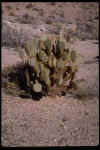
|
| 2A. |
Stems are
round and jointed
Photo by credit J. E.(Jed) and Bonnie
McClellan, California Academy of Sciences
|
COASTAL CHOLLA |
|
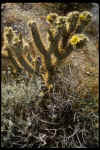 |
| 3. |
Vine-like
plant, climbing with tendrils or stems |
go
to 4 |
|
|
| 3A. |
Upright tree
or shrub, maybe sprawling (spread out) |
go
to 5 |
|
|
| 4. |
Leaves
arrow-shaped, funnel shaped white flower
Photo by Brother Alfred Brousseau, St.
Mary's College.
|
BINDWEED |
|


|
| 4A. |
Leaves
palmate, flowers small white in raceme, spiny fruit
Photo by Brother Alfred Brousseau, St.
Mary's College.
|
WILD CUCUMBER |
|
 |
| 5. |
Plant a tree
definitely woody stem |
go
to 6 |
|
|
| 5A. |
Plant a shrub
or annual, woody or herbaceous |
go to 11 |
|
|
| 6. |
Palmate large
fuzzy leaves |
SYCAMORE |
|


|
| 6A. |
Leaves not as
above |
go
to 7 |
|
|
| 7.
|
Leaf margin
toothed or serrated |
go
to 8 |
|
|
| 7A.
|
Leaf margin
entire or lobed |
go to 10 |
|
|
| 8. |
Leaves
compound pinnately- usually 5-9 leaflets |
ELDERBERRY |
|
|
| 8A.
|
Leaves simple
or lobed |
go
to 9 |
|
|
| 9. |
Leaves ovate,
tip slightly pointed
Photo by Brother Alfred Brousseau, St.
Mary's College.
|
WHITE ALDER |
|
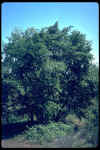
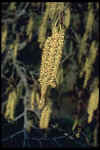
|
| 9A. |
Leaves at
least 3X as long as wide, toothed, red berries
Photo by Brother Alfred Brousseau, St.
Mary's College.and William R. Hewlett, California Academy of
Sciences.
|
TOYON |
|


|
| 10. |
Flowers
yellow, tubular, leathery leaves |
TREE TOBACCO |
|
|
| 10A. |
Flowers tiny
yellow catkins, linear pointed leaves
Photos by Charles Webber, California
Academy of Sciences and Brother Alfred Brousseau, St. Mary's College
|
ARROYO WILLOW |
|
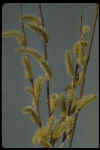

|
| 11. |
Stems with
spines or thorns |
go
to 12 |
|
|
| 11A |
Stems without
spines |
go
to 14 |
|
|
| 12. |
Leaves <
1" lobed at tip, red tubular flowers, spiny fruit
Photos by Brother Alfred Brousseau, St.
Mary's College and John Game
|
FUCHSIA FLOWERED
GOOSEBERRY |
|
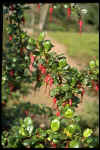
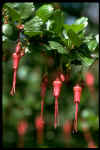
|
| 12A. |
Leaves larger,
deeply cleft |
go
to 13 |
|
|
| 13. |
Leaves large
tipped with spines, terminal large blue flower |
WILD ARTICHOKE |
|


|
| 13A. |
Leaves not
spiny, like sandpaper, deltoid, fruit spiny
Photos by Donald Myrick, California
Academy of Sciences and Brother
Alfred Brousseau, St. Mary's College
|
COCKLEBUR |
|


|
| 14. |
Wooly white
hairs on leaves and/or stem |
go
to 15 |
|
|
| 14A. |
Plant no as
above |
go
to 16 |
|
|
| 15. |
Leaves
opposite, wrinkled, flowers white, whorled
Photos by Virginia Moore, California
Academy of Sciences and Beatrice F. Howitt, California Academy of
Sciences.
|
HOREHOUND |
|
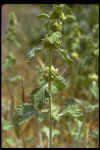

|
| 15A. |
Leaves
alternate |
go
to 17 |
|
|
| 16. |
Growth habit
sprawling |
go
to 18 |
|
|
| 16A. |
Upright shrub |
go
to 19 |
|
|
| 17. |
Tall herb,
leaves green on top, white hairy beneath
Photos by Brother Alfred Brousseau, St.
Mary's College.
|
CUDWEED |
|


|
| 17A. |
tall herb,
leaves green below, smells like curry
Photos by Brother Alfred Brousseau, St.
Mary's College.
|
PEARLY
EVERLASTING |
|

|
| 18. |
Low shrubby
plant, leaves in 3, yellow-orange tiny flowers
Photos by Brother Alfred Brousseau, St.
Mary's College.
|
DEERWEED |
|

|
| 18A. |
Gray-green
shrub, triangular leaves, no petals
Photo by Brother Alfred Brousseau, St.
Mary's College.
|
SALTBUSH |
|
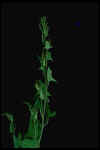 |
| 19. |
Leaves finely
dissected, fernlike or stringy |
go
to 20 |
|
|
| 19A. |
Leaves
toothed, entire, lobed, or palmate |
go
to 24 |
|
|
| 20. |
Leaves gray,
stingy, strong sage smell
Photos by Brother Alfred Brousseau, St.
Mary's College.
|
CALIFORNIA
SAGEBRUSH |
|

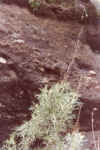

|
| 20A. |
Leaves green,
stringy |
go
to 21 |
|
|
| 21. |
Leaves finely
dissected or fernlike |
go
to 22 |
|
|
| 21A. |
Leaves not as
above |
go
to 23 |
|
|
| 22. |
Flowers
yellow, in umbel, smells and tastes like licorice |
SWEET FENNEL |
|
|
| 22A. |
Flowers white,
in umbel, feather-like leaves
Photos by Brother Alfred Brousseau, St.
Mary's College.
|
YARROW |
|


|
| 23. |
Flowers
nondescript, stems reddish, leaf and stem prickly
Photo by Charles Webber, California
Academy of Sciences
|
RUSSIAN
THISTLE |
|
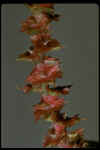 |
| 23A. |
Flowers creamy
turning rusty in cluster, leaves small pointy
Photos by Brother Alfred Brousseau, St.
Mary's College.
|
WILD BUCKWHEAT |
|


|
| 24.
|
Leaves toothed
or loosely serrated, at least some |
go
to 25 |
|
|
| 24A. |
Leaves linear,
entire, or lobed, not serrate |
go
to 29 |
|
|
| 25. |
Leaves
compound |
go
to 26 |
|
|
| 25A. |
Leaves simple,
long, linear, flowers in clusters |
go
to 27 |
|
|
| 26. |
Leaves 7-9
palmately compound, flowers blue-purple raceme
Photos by Brother Alfred Brousseau, St.
Mary's College.
|
LUPINE |
|

|
| 26A. |
Leaves
smaller, cleft into leaflets, ovate |
go
to 28 |
|
|
| 27. |
Leaves large,
linear tall plant, more than 6", reddish spike flower
Photo by Brother Alfred Brousseau, St.
Mary's College.
|
CURLY DOCK |
|
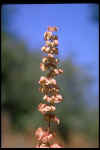 |
| 27A.
|
Leaves
slightly toothed or entire, small terminal creamy cluster flower
Photo by Brother Alfred Brousseau, St.
Mary's College.
|
MULE FAT |
|
 |
| 28. |
Leaves in
3-leaflets, flowers yellow spike
Photo by Brother Alfred Brousseau, St.
Mary's College.
|
YELLOW SWEET
CLOVER |
|
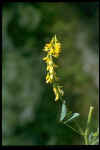 |
| 28A. |
Leaves in
3-leaflets, flowers white spike |
|
|
|
| 29. |
Plant shrub
with whitish or gray leaves |
go
to 30 |
|
|
| 29A. |
Plant shrub
with green or reddish leaves |
go
to 31 |
|
|
| 30. |
Flowers
yellow, composite, linear leaves, sessile, some toothed |
GOLDENBUSH |
|
|
| 30A. |
Flowers
yellow, woody shrub, with fat pods
Photos by Brother Alfred Brousseau, St.
Mary's College.
|
BLADDERPOD |
|
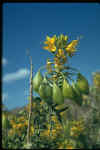

|
| 31. |
Leaves thick
and leathery |
go
to 32 |
|
|
| 31A. |
Leaves not as
above |
go
to 33 |
|
|
| 32. |
Large shrub,
ovate leaves, slimy hard berries, taste like lemons
Photo by Charles Webber, California
Academy of Sciences.
|
LEMONADE BERRY |
|
 |
| 32A. |
Large shrub,
leaves entire, fold in middle, stems reddish
Photos by Brother Alfred Brousseau, St.
Mary's College.
|
LAUREL SUMAC |
|

|
| 33. |
Leaves entire |
go
to 34 |
|
|
| 33A. |
Leaves entire |
go
to 34 |
|
|
| 34. |
Weak stemmed,
yellow composite with purplish center
Photo by Larry Blakely
|
ENCELIA DAISY |
|


|
| 34A. |
Strong stemmed
bush, 5-9 toothed small leaves |
COYOTE BUSH |
|
 |
| 35. |
Leaves
opposite |
go
to 36 |
|
|
| 35A. |
Leaves
alternate |
go
to 37 |
|
|
| 36.
|
Leaves sticky,
linear, flowers red or salmon colored
Photos by Brother Alfred Brousseau, St.
Mary's College.
|
MONKEY FLOWER |
|
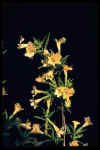


|
| 36A. |
Leaves no
sticky, flowers whored, lavender color
Photo by Charles Webber, California
Academy of Sciences.
|
BLACK SAGE |
|
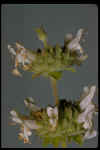 |
| 37.
|
Leaves simple |
go
to 38 |
|
|
| 37A. |
Leaves in
three, shiny reddish to green |
POISON OAK |
|
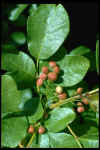
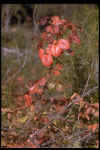
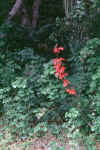
|
| 38. |
Flowers
reflexed white, yellow pistil, fruit green or purple berry
Photos by Beatrice F. Howitt, California
Academy of Sciences and Charles Webber, California Academy of
Sciences.
|
NIGHTSAGE |
|


|
| 38A. |
Leaves large
round or heart-shaped, flower pinkish, fruit round |
CHEESEWEED |
|
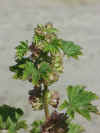 |